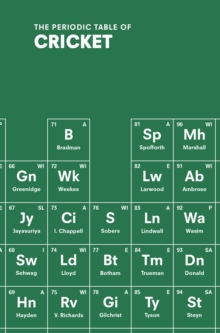The Periodic Table of Cricket
Martin Chandler |Published: 2016
Pages: 152
Author: Stern, John
Publisher: Ebury Press
Rating: 3 stars

I’m afraid the comparison to the Periodic Table is rather lost on me, so it is good to be able to report that relates only to the presentation of this book rather than its content. The basic premise is simple enough, and has been done plenty of times before by many of the great and the good of cricket writing, so John Stern has a number of hard acts to follow.
The Periodic Table of Cricket is a collection of 114 pen portraits of, in the main, the best known cricketers to have played the game. There is no getting away from the fact that for those of us who are not the target market for the book one pleasure is in criticising the selection. I suppose this might be one area where the periodic table approach does help to deflect any criticism on the point, but I still found myself wondering why names like Tom Graveney, Colin Cowdrey, Peter May, Ted Dexter, Ken Barrington, Neil Harvey and Alan Davidson were missing.
On the other hand, because of the way Stern sets about his task, there are a number of men whose achievements with bat and ball could never justify their place amongst the finest 114 to have played the game, but who fit well within the framework Stern has chosen; men like Mohammad Nabi, Bernard Bosanquet, Colin Bland, Mike Brearley and Hansie Cronje.
To my mind this is the sort of book that should be bought by, or perhaps more realistically given as a gift to, those who are just beginning to enjoy the game of cricket and who want (or do I mean need?) to know more about the history of the game. Put another way those who will become the next generation of cricket tragics. On that basis there is a great weight of responsibility on those who compile such books.
The real challenge in writing this sort of book is not so much deciding what to include within a budget of 400 or so words per subject as what not to say. Those of us who write almost exclusively for websites rarely have to trouble ourselves with that dilemma, but it is not lost on me how difficult a task it is.
Some of the summaries are excellent. That of Alec Bedser is one such, and a novice historian is given all the information he or she will need to decide whether to take any further interest in the great English medium pacer. I enjoyed the piece on Barry Richards, not because of any particularly great writing, but because it told me Richards had scored a century before lunch as many as nine times. It is rare for the seasoned cricket tragic to learn anything from this sort of book, but that was certainly one occasion.
One of my great heroes, Douglas Jardine, finds his way into the book. It is a good summary of one of England’s most famous skippers, but why is it that people who write short pieces about Jardine never make the point that he gave the best possible answer to his critics in scoring a century against Bodyline on the only occasion he had an opportunity to bat against it?
All in all The Periodic Table of Cricket is an excellent introduction to the personalities whose deeds have been the foundation of the game’s rich history. It is well written, neatly summarises its subjects and does not make the mistake of dwelling on numerical content, which is probably just as well given that Donald Bradman’s highest innings is mistakenly stated to be 454.







Leave a comment